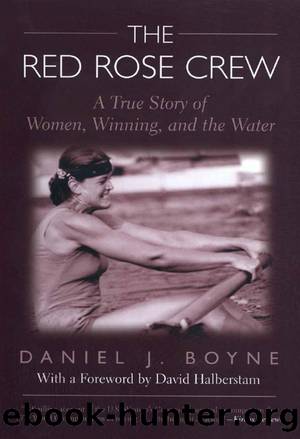Red Rose Crew by Daniel Boyne

Author:Daniel Boyne
Language: eng
Format: epub
Publisher: Lyons Press
COACHING FROM A LAUNCH was a sometimes cumbersome but necessary way to groom a crew. Before gas-fired engines were available, some coaches used bicycles or even sculled alongside their crews. These forms of locomotion had their obvious deficiencies. The single scull might be handy to demonstrate technique to a novice crew, but an experienced boat could easily outrow a single. Coaching from a bicycle might be a little better, depending on the condition of the path along the river and its proximity to the water. On the Charles, however, the bike paths were shielded from the river by a thin wall of trees in many places, making this option impractical. A launch was the only way to do the job well.
A launch allowed a coach to view his crew from all angles, to examine it with a casual but careful eye. He could follow directly behind the crew, to check the timing of all the port, and then the starboard, oars. This was the coxswainâs perspective, and from here it was easy to see if the blades were going in and out of the water together, or if one of them was slightly off at the catch. From here you could also study the boatâs balance, whether it was âset upâ solidly in between strokes, or whether it tended to dip down to one side.
A good coxswain could take care of these matters for you, the balance and the bladework, so that you could motor up alongside the crew to get a better look at the rowers themselvesânot only how well they were swinging into the bow together and preparing their upper bodies for the next stroke, but more subtle, finer nuances such as how they were holding their arms and wrists. For this reason, it was very important for a coach to get someone good in the coxswainâs seat very quickly, even before the rest of the crew was selected. A good coxswain allowed a coach to get about his other business without worrying whether the crew was going to hit a bridge. But first, of course, a coxswain had to know how to steer.
You couldnât really teach someone how to do this; it was something that came by feel, or it didnât. There were simply too many variables at work, all coming into play at the same time. Not only did a coxswain have to deal with the effects of wind and current on the boat, and discrepancies in the power of the rowers, but she also faced the more basic fact that there were no road maps or even buoys on most rivers. Constant dead reckoning was required.
For all of these reasons, coxing an eight was much harder than driving a car. It was much more like flying a small airplane. You had to gauge the weather around you and the speed of your craft to predict, ahead of time, how to adjust your course. You had to know that it was much easier to land the
Download
This site does not store any files on its server. We only index and link to content provided by other sites. Please contact the content providers to delete copyright contents if any and email us, we'll remove relevant links or contents immediately.
The Inner Game of Tennis by W. Timothy Gallwey(3576)
Unstoppable by Maria Sharapova(3484)
Urban Outlaw by Magnus Walker(3342)
Crazy Is My Superpower by A.J. Mendez Brooks(3332)
Mind Fuck by Manna Francis(3132)
The Social Psychology of Inequality by Unknown(2941)
The Fight by Norman Mailer(2849)
Unstoppable: My Life So Far by Maria Sharapova(2456)
Accepted by Pat Patterson(2308)
Futebol by Alex Bellos(2301)
Going Long by Editors of Runner's World(2298)
Motorcycle Man by Kristen Ashley(2200)
Sea Survival Handbook by Keith Colwell(2199)
The Happy Runner by David Roche(2194)
Backpacker the Complete Guide to Backpacking by Backpacker Magazine(2193)
The Sports Gene: Inside the Science of Extraordinary Athletic Performance by David Epstein(2135)
Peak: Secrets from the New Science of Expertise by Anders Ericsson & Robert Pool(1989)
Endure by Alex Hutchinson(1967)
The Call of Everest by Conrad Anker(1868)
